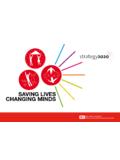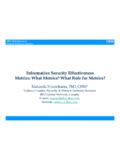Transcription of M&E framework and implementation final
1 Monitoring and evaluation framework for the global strategy and Plan of Action on Public Health, Innovation and Intellectual Property Draft for discussion Written by Claudia Nannei, MSc Approved by Dr Zafar Mirza WHO Department of Public Health, Innovation and Intellectual Property 24 January 2011 Draft 2 Table of contents ABOUT THIS The global strategy and Plan of Action on Public Health, Innovation and Intellectual The three levels of implementation for the global MONITORING AND EVALUATION framework Aim and objectives of the M&E Result-Based Management and monitoring The logic implementation OF THE implementation approaches for element 8 "Establishing monitoring and reporting systems".
2 12 Work-plan for M&E framework development and 1) strategy implementation arrangements at regional/country level and corresponding national M&E 2) 2012 and 2014 Progress 3) Web-based platform for the M&E of 4) Programme revision and comprehensive evaluation (2014-2015)..19 LEARNING BY ANTICIPATED Annex Annex Annex Draft 3 ABOUT THIS DOCUMENT This document gives an overview of the monitoring and evaluation framework for the global strategy and Plan of Action on Public Health, Innovation and Intellectual Property (GSPA-PHI) developed by the Department of Public Health, Innovation and Intellectual Property (PHI).
3 This document explains also how PHI will implement the monitoring and evaluation plan, focusing in particular on the outline of the reporting mechanism to be set up by WHO. One of the element of the GSPA-PHI (Element 8) states that: Systems should be established to monitor performance and progress of the strategy . A progress report will be submitted to the Health Assembly through the Executive Board every two years1. A comprehensive evaluation of the strategy will be undertaken after four years 2. Additionally, action ( ) establishes that measuring performance and progress towards objectives contained in the GSPOA should include the following activities and priority issues: a) Establish systems to monitor performance and progress of the implementation of each element of the GSPOA.
4 This document illustrates the development of the implementation of action a). BACKGROUND The global strategy and Plan of Action on Public Health, Innovation and Intellectual Property Lack of innovation and access to existing health products, including diagnostics, vaccines and medicines, remains one of the most serious global health problems. Although considerable progress in terms of global access to health products has been made in recent years, including with regard to the prevention, diagnosis and treatment of diseases, developing countries nevertheless often remain excluded from the benefits of modern science and access is hindered by a variety of complex and intertwined factors, including among many other high medicine prices, lack of financing of R&D of relevant diseases, unfavourable trade agreements, low innovative capacity in some countries, weaknesses in drug procurement and supply management and weak health systems.
5 The global strategy and Plan of Action on Public Health, Innovation and Intellectual Property was approved by WHO Member States in 2008 and offers a holistic approach to this complex issue. It aims to stimulate new thinking on access to medicines and innovation. The GSPA-PHI proposes objectives and priorities for setting the R&D needs-based agenda, for promoting innovation and associated skills in countries, for sharing existing knowledge through technology transfer initiatives and the management and application of intellectual property rights according to pro-public health criteria, to improve access to medicines as well as to mobilize resources.
6 Responsibility for implementation is scattered among a large number of diverse stakeholders, including governments, academia, civil society organizations, international intergovernmental organizations and the private sector. 1 2010, 2012 and 2014 2 2012 Draft 4 The breath of the strategy is vast and challenging and the WHO Department of Public Health, Innovation and Intellectual Property (PHI) is required to set up a performance monitoring system in order to provide member states and the other stakeholders with regular up-dates on the results achieved and evidence on the future needs for their interventions.
7 The three levels of implementation for the global strategy The implementation plan for the global strategy represents the way GSPA-PHI intends to engage itself and the relevant stakeholders in the realization of the objectives of the GSPA-PHI. According to the plan Member States are the key stakeholders that are to take forward many of the specific actions specified in the GSPA while it is the role of the WHO to provide them with technical assistance and evidence to inform their decision-making process. The plan has been developed, together with the global stakeholders and experts in each specific field covered by the elements of the strategy , with a view to providing a clear vision of the process that WHO is setting up to implement the strategy .
8 Finalization of this implementation plan, however, cannot be completed without involving the six WHO regional offices and Member States. This means that the implementation plan will take place at three levels: a) at the global level, where activities are carried out in collaboration with global partners and where WHO, given its role and convening power, will assume a primary role in taking the activities forward; b) at the regional level, where initiatives will be developed that engage the regions; c) at the national level, where ownership and endorsement is assured and the gap in the country's capacities to innovation in health is addressed.
9 MONITORING AND EVALUATION framework STRUCTURE Aim and objectives of the M&E framework The aim of the monitoring and evaluation framework is as follow: To create evidence for informed decision making for Member States, mainly at policy level, and to provide information for accountability and performance improvement. The objectives are: To develop a mechanism that allows for an understanding and monitoring of the progress made by stakeholders in the implementation of specific actions of the global strategy To help countries to build their own M&E system that can be used to measure countries' progress To give policy makers the possibility to evaluate long-term changes produced by the strategy on relevant issues, such as innovation and access to health products.
10 Sustainable resource mobilization for health research and enhancement of needs-driven essential health research relevant to diseases that disproportionally affects developing countries. Result-Based Management and monitoring approach In the Programme for Reform , presented by the former United Nation (UN) Secretary General to the UN General Assembly in 1997, Kofi Annan proposed that the UN placed greater emphasis on results in its planning, budgeting and reporting with the aim of shifting the United Nations Draft 5 programme budget from a system of input accounting to results-based . The focus of planning, budgeting, reporting and oversight thereby shifted from how things are done to what is accomplished.

















